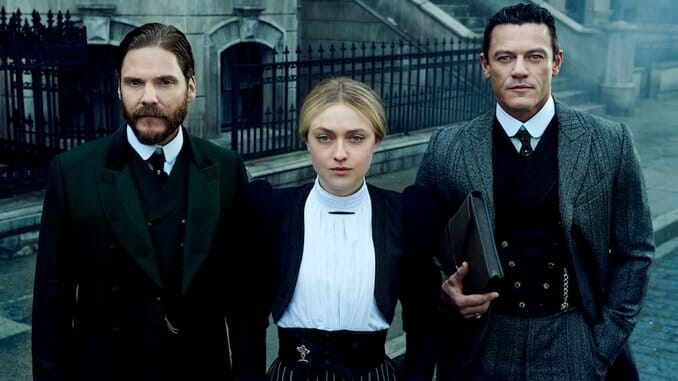The Alienist: Angel of Darkness: TNT’s Gilded Crime Drama Returns with a Beautiful, Better Season 2
Photo Courtesy of TNT
The first season of TNT’s The Alienist, which sets a conventional subgenre (psychology-based police procedural) during an unconventional time (the late Gilded Age), was too hiccupy to flourish and too gorgeously gruesome to ignore. If Hannibal set the bar for “how did they get away with that” crime TV, The Alienist was limping not too far behind with a ridiculous old-timey mustache and a killer waistcoat. But the second season, subtitled Angel of Darkness after the novel of the same name by source author Caleb Carr, improves its storytelling significantly while maintaining one of the most interesting aesthetics on air.
A year has passed since the events of the first season: it’s 1897 and Dr. Laszlo Kreizler (Daniel Brühl) is back as your great-great-great-grandpappy’s criminal psychologist AKA alienist. The blessings of history have sent Teddy Roosevelt (a weak link from last season) out of the picture, having been appointed Assistant Secretary of the Navy. That leaves The Alienist’s Ye Olde Mystery, Inc. firmly in the hands of its central trio. Intense, driven Sara Howard (Dakota Fanning) now runs her own detective agency while timid, fidgety John Moore (Luke Evans) hangs on her every word, writes at the New York Times, and falls deeper into high society politics. The season wastes no time assembling the squad, which must solve a rash of baby-nappings.
The Spanish-American War is on the horizon and Ana Linares (the infant daughter of a Spanish diplomat) is missing. Did someone say “Remember the Maine! To hell with Spain?” If so, it was likely warmonger, newspaper baron, and Citizen Kane inspiration William Randolph Hearst (Matt Letscher). His New York Journal has a lovingly recreated issue printed as an early prop and his goddaughter, Violet (Emily Barber, scene-stealing), is now engaged to John. Hearst, like Cornelius Vanderbilt and a few other historical figures, pops up as both period set dressing and thematic anthropomorphization. Not only are infants going missing, but the politics of their retrieval are hinged upon sex, class, and xenophobia.
The newborn-snatching crime is a physical manifestation of the female oppression that the show’s interested in from the jump. Not only is Howard breaking barriers strained in the first season, she’s helping protest for women’s suffrage. Her investigation and shift to full protagonist status grant the season’s central crime an ideological angle: there is a war in New York between those humanizing women as political entities, those dehumanizing them by reducing them to base biological ability, and those wondering why women are being asked to choose in the first place.
A dirty, cry-filled Lying-In Hospital makes this conflict into an aesthetic reality as the camera focuses on blood, baths, hair, and veins. The women inside, placed there by wealthy men looking to rid themselves of pesky pregnancies, plead for personhood. The writing finds some much-needed depth in these relatively simple thematic overtones, weaving income and gender inequality throughout its caper and character work.
Evans’ performance continues to be engagingly wimpy and soft-spoken, making Fanning’s even beefier by comparison. It’s a good dynamic, leading this motley crew—which includes the forensic expert Isaacson brothers (Douglas Smith and Matthew Shear, effortlessly charming) and bartender Cyrus (Robert Ray Wisdom)—and adding a nice dash of suppressed desire to an already rich show. The platonic stern detective / admiring reporter relationship is right out of a juicy romance and, thanks in part to the work of editor Dermot Diskin, offers a reprieve from a show that can get utterly grim. Like, lots of dead babies grim.
The grotesquery on display this year is downright spooky, kicked off by a well-directed pilot filled with horror flourishes. From the opening moments—horse-and-carriage action (that drives home how terrifying it must have been to live during a time when people could just speed their giant animals through streets that were basically crowded sidewalks), and the most upsetting electric chair execution outside of The Green Mile—to the throwaway scene kiss-offs that leave us dangling in fun, silly, or otherwise inconsequential ways, the show’s pacing has gotten an energy boost without sacrificing any of the fun nastiness.
-

-

-

-

-

-

-

-

-

-

-

-

-

-

-

-

-

-

-

-

-

-

-

-

-

-

-

-

-

-

-

-

-

-

-

-

-

-

-

-








































